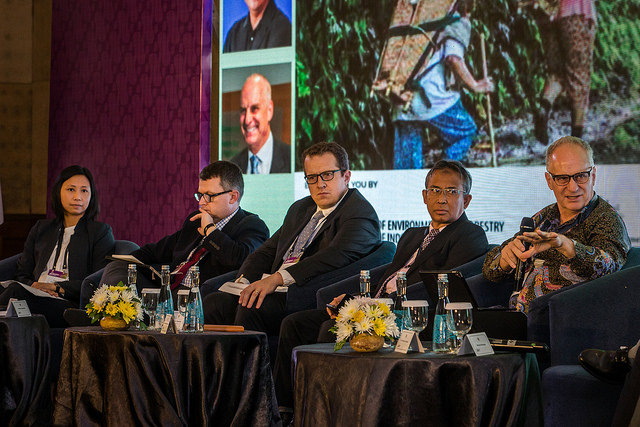Forests play a critical role in meeting climate goals and sustainable development targets. The main focus of the 3rd Asia-Pacific Rainforest Summit (APRS 2018) was to analyse practical ways in which forest policies and actions can contribute to each country’s Nationally Determined Contributions (NDCs) under the Paris Agreement.

“I believe that in the region we can nail it,” expressed Indonesia’s Minister of Environment and Forestry, Siti Nurbaya, during the opening of the event. “What we need to do is to identify the most significant roles of forests in the NDCs and do our best to undertake the necessary measures.”
More than 1,200 participants from over 40 countries across Asia-Pacific attended the summit this week in Yogyakarta, Indonesia. This event was co-hosted by the Indonesian Minister for Environment and Energy, Siti Nurbaya, and the Australian Minister for Environment and Energy, Josh Frydenberg.
Under the theme “Protecting forests and people, supporting economic growth”, the key regional event focused on conservation, livelihoods and investment.
One of the central topics discussed was how to operationalise REDD+ in the region. Panellists agreed that it is necessary to include private sector, financial institutions and other stakeholders at the very beginning of the process, during the policy-making stage.
“Ministries of forestry and environment are the heart and soul of REDD+ programs, but we need to talk to the private sector and other ministries,” remarked Danae Maniatis, from the United Nations Development Programme. It is also essential to make forests more attractive for investment, by boosting transparency and the rule of law and defining land ownership. In addition, agriculture and forestry companies need incentives, so they can balance productivity with ecological protection.
Connecting forest finance
Many participants and delegates showed interest in the session discussing the role of finance, investment and trade in forest conservation and restoration. One of the conclusions of the panels was that funds are available, but it is hard to connect them to desirable investment opportunities. It is also challenging for projects to receive the funds. Currently, several approaches to innovative finance tools are being tried, including ecosystem bonds and forest bonds.
The lessons learned so far from these experiences are that conservation needs to be a fundamental part of market values – particularly related to sustainable commodities – and that climate finance should focus on projects that might require high investments but will have a large impact on reducing greenhouse gas emissions.
Another key point was that, in order to get all stakeholders on board, government should set a standard for everyone to act according to sustainable development policies. “It is more important to change behaviours; we need to have a new type of behaviour for all stakeholders,” said Laksmi Dhewanti, from Indonesia’s Ministry of Environment and Forestry. “We don’t have any other choice but to be ambitious,” she added.
Jack Hurd, from The Nature Conservancy, expressed the need for a change of paradigm. “Public and private sector, community groups and others are embracing forests but that goes against current economic models. The question is, ‘how do we make forests part of economic strategies?'”
Community forests and mangroves are powerful tools
Countries in the region are increasingly recognising the importance community forests have in avoiding deforestation. At the summit, delegates discussed policy and implementation solutions to support social forestry and community forestry. Panellists highlighted the shift in this field, which has expanded from focusing only on the community to including broader issues, such as linking these initiatives to finance institutions and markets.
At the ground level, some examples showed that social forestry and community forestry could also be the answer to land tenure issues. The event called for innovative approaches to community forestry that follow inclusive business models, to ensure equity and the fair sharing of profits. Panellists also reminded participants of the need to consider the possible social and conservation impacts of community forestry projects.
Mangroves and “blue carbon” were highlighted at the event as a potential tool to be included in Indonesia’s Nationally Determined Contributions. Experts pointed out that mangroves could also serve as a financial incentive to prevent deforestation under the mechanism of payments for ecosystem services. In both cases, “blue carbon” will need to be incorporated into coastal spatial planning systems and local communities’ economic viability mechanisms.
The summit also showcased national experiences and best practices in the areas of Ecotourism and conservation of biodiversity; Production forests; and Restoration and sustainable management of peatlands.
In addition to public sessions, the Asia-Pacific Rainforest Summit was an opportunity for ministerial and bilateral meetings, to advance regional cooperation on specific areas where one country’s expertise could be useful to others. The event also served as a platform for people working in the environment and forestry sectors, who were able to meet, exchange ideas and explore potential opportunities for collaboration.
